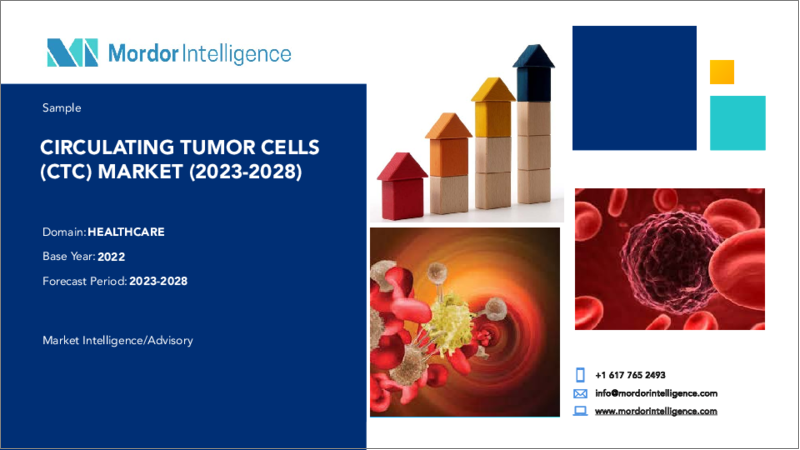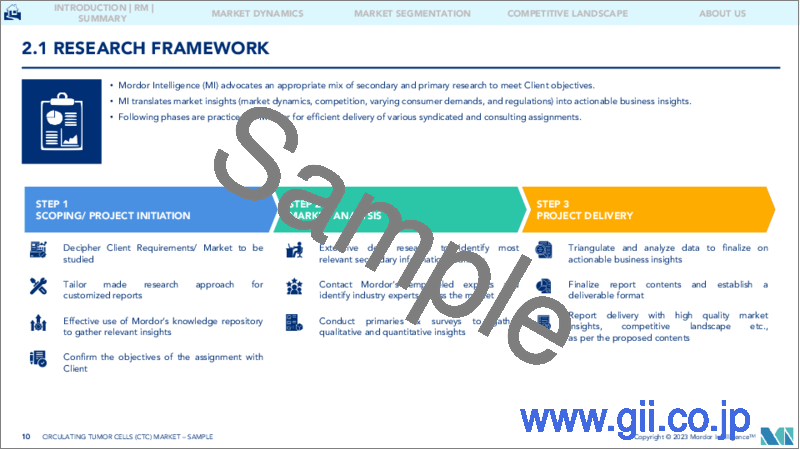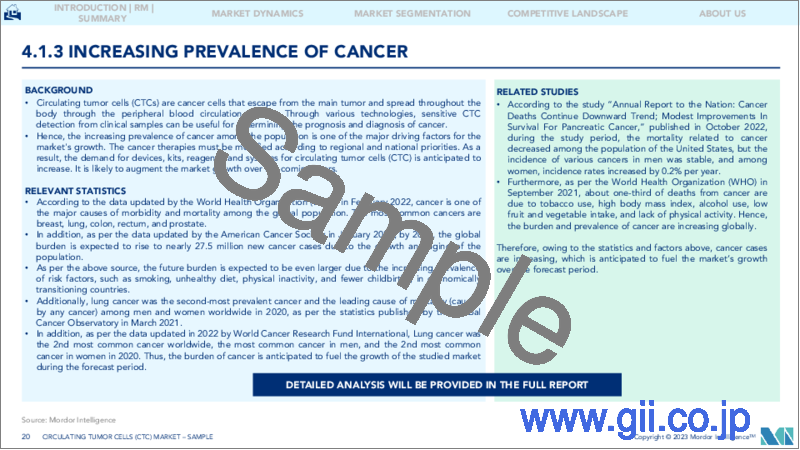|
|
市場調査レポート
商品コード
1190306
循環腫瘍細胞(Ctc)市場- 成長、動向、予測(2023年-2028年)Circulating Tumor Cells (Ctc) Market - Growth, Trends, and Forecasts (2023 - 2028) |
||||||
|
● お客様のご希望に応じて、既存データの加工や未掲載情報(例:国別セグメント)の追加などの対応が可能です。 詳細はお問い合わせください。 |
|||||||
| 循環腫瘍細胞(Ctc)市場- 成長、動向、予測(2023年-2028年) |
|
出版日: 2023年01月18日
発行: Mordor Intelligence
ページ情報: 英文 112 Pages
納期: 2~3営業日
|
- 全表示
- 概要
- 目次
循環腫瘍細胞(CTC)市場は、予測期間(2022~2027年)にCAGR9.5%を記録すると予想されています。
COVID-19のパンデミックは、世界中のヘルスケアシステムに影響を与え、多くの医療施設で通常の治療が中断され、脆弱ながん患者が大きなリスクにさらされる結果となりました。例えば、「Impact of the COVID-19 Pandemic on Cancer Care:2020年9月の「A Global Collaborative Study」では、6大陸54カ国から合計356のセンターが4月21日から5月8日の間に参加したことが報告されています。これらの施設は、毎年716,979人の新しいがん患者さんに対応しています。そのほとんど(88.2%)が、パンデミック時にケアを提供する上で課題に直面したと報告しています。55.34%が先制戦略の一環としてサービスを縮小しましたが、その他の一般的な理由として、システムの過負荷(19.94%)、個人防護具の不足(19.10%)、スタッフ不足(17.98%)、薬へのアクセス制限(9.83%)などが挙げられました。したがって、これはCOVID-19のために、化学療法や放射線療法サービスの減少や進行中の研究開発研究に関するがん医療に混乱が生じ、それによって市場の成長に影響を与えたことを示しています。
さらに、2021年9月に発表された研究「Association of COVID-19 Lockdown With the Tumor Burden in Patients With Newly Diagnosed Metastatic Colorectal Cancer」は、循環腫瘍DNAを通じてCOVID-19によるロックダウンの新規診断大腸がん例への影響を評価し、ロックダウン後に診断を受けた患者の腫瘍負担がロックダウン前に診断を受けた患者と比べて有意に高かったと報告しています。この研究により、COVID-19実施中に腫瘍負荷が大きく増加し、その結果、市場成長に劇的な影響を与えることが示されました。
循環腫瘍細胞(CTC)市場の成長の主な要因は、バイオメディカルイメージングおよびバイオエンジニアリング技術の進歩、予防医学およびコンパニオン診断の需要の高まり、およびがんの有病率の増加です。
世界的にがんの負担が増加しているため、がん治療は地域や国の優先順位に従って変更する必要があります。例えば、世界保健機関(WHO)による2021年9月の更新によると、2020年の世界の死亡者数は、がんが約1,000万人を占めています。2020年に最も多かったのは(がんの新規発生数で)、乳房(226万件)、肺(221万件)、結腸・直腸(193万件)、前立腺(141万件)、皮膚(非メラノーマ)(120万件)、胃(109万件)でした。
また、Globocanによる2020年の統計では、2020年にがんと診断された人は19,292,789人となっています。前述の同資料では、2040年にはがん患者数が3,020万人に達すると推定されています。がんの負担増は、人口の増加や高齢化、社会的・経済的発展に伴う特定のがん原因の有病率の変化など、いくつかの要因に起因しています。例えば、世界保健機関(WHO)によると、2021年9月には、がんによる死亡の約3分の1は、タバコの使用、高体重指数、アルコール使用、果物や野菜の摂取量の少なさ、身体活動の不足に起因するとされています。したがって、タバコの消費量の増加は、がんの有病率の増加を引き起こすと予想され、それによって市場の成長に貢献することが期待されます。
さらに、最近の臨床研究で得られた良好な結果も、今後の市場の大きな成長につながる可能性があります。例えば、「Heat Shock Protein(HSP)70 to Quantify and Characterize Circulating Tumor Cells in Patients With Advanced or Metastatic Tumors」と題する研究が2021年2月に開始され、熱ショックタンパク質HSP70が進行または転移腫瘍の患者における循環腫瘍細胞(CTC)を分離・定量する能力を評価することが明らかになりました。
したがって、上記の要因によって、調査対象市場は調査期間中に大きく成長すると予想されます。しかし、診断費用の高さ、認識不足、高度なCTC技術の採用意欲の低さに関連するCTCの検出と特性評価における技術的な困難が、市場の成長をさらに妨げると予測されます。
主な市場動向
循環腫瘍細胞(CTC)市場では、ネガティブエンリッチメントセグメントが主要な市場シェアを占めると予想される
ポジティブエンリッチメント法の場合、不均一な性質によってCTCを分離することができません。しかし、ネガティブエンリッチメント法では、血球を精密に除去することで、異質かつ無傷のCTCを分離することができます。このようなネガティブエンリッチメント技術の優位性により、今後、採用が進むと予想されます。
さらに、さまざまな種類のがんの有病率が上昇していることも、近い将来、このセグメントの成長を後押しすると予想されます。国際がん研究機関(International Agency of Research on Cancer)の2020年統計によると、肝臓がんは世界で6番目に多いがんであり、がん死亡原因の第3位で、新規患者数は905,677人、死亡者数は830,180人と推定されています。発生率は東アジアが最も高く、491,687例でした。さらに、北米では46,599人、西欧では26,128人の発生率でした。全体として、肝臓がんの罹患率は、男性が女性の約3倍となっています。
さらに、2022年1月に米国がん協会が発表した論文によると、腎臓がんは米国で男女ともに最も多い10種類のがんのうちの一つです。全体として、腎臓がんの生涯発症リスクは、男性で約46人に1人、女性で約80人に1人と、かなり高いことがわかります。このような負担の増大に伴い、がんの予防は最も重要な課題の一つとなっています。循環腫瘍細胞の解析は、疾患の進行や治療に対する反応のモニタリング、特に新規抗がん剤のコンパニオン診断や疾患進行のメカニズムに関する研究において、重要な位置を占めています。
また、ネガティブエンリッチメントは、CTCの分離においてポジティブエンリッチメントよりも優れており、そのため、このセグメントは予測期間中に高い成長を示すと予想されます。例えば、2021年10月に発表された「Negative enrichment of circulating tumor cells from unmanipulated whole blood with a 3D printed device」と題する研究では、ネガティブ濃縮アプローチは、CTCの偏りのない検出につながり、また付着免疫剤を含まない無傷の腫瘍細胞を生成し、下流研究での潜在的アーチファクトを排除するので有利であると述べています。このように、他の濃縮技術に対するネガティブ濃縮法の優位性により、市場セグメントは大きく成長すると予想されます。
このように、市場セグメンテーションは、上記の要因により、市場の成長に大きく貢献することが期待されます。
北米が市場で重要なシェアを占め、予測期間中も同様と予想される
北米は、がんの負担の増加、製品の承認、研究開発活動の活発化などの要因から、市場の大幅な成長に貢献すると予想されます。例えば、2022年米国がん協会の推計によると、2022年には同国で新たに約236,740例の肺がんが診断される予定です。また、同資料では、2022年に腎臓がんによる新規症例が79,000件、死亡が13,920件報告されるとされています。がんの高い負担は、CTC検出キットの需要を押し上げ、それによって市場の成長を促進することが期待されます。
さらに、調査対象市場における製品承認は、市場成長をさらに促進すると予想されます。例えば、2020年11月、食品医薬品局(FDA)は、リキッドバイオプシーとして知られる血液検査の承認用途を拡大し、医師ががん患者の一部に対して最善の治療法を選択するのに役立つようにしました。この検査は、血液中に放出された腫瘍細胞のDNAから、がんに関連する遺伝子の変化を特定するものです。
さらに、2020年2月に発表された研究「Cancer cells alter protein production machinery to hasten metastasis」によると、乳がん患者の血液から濃縮したCTCはリボソーム蛋白質(RP)のレベルが高く、その存在は疾患の攻撃性の増加および臨床転帰不良と関連していると言われています。したがって、CTCにおけるリボソームタンパク質の存在を評価する研究は、効果的ながん診断につながるため、市場を牽引することになります。また、米国には、米国食品医薬品局(FDA)から承認された最も成功した製品の1つであるCellSearch Circulating Tumor Cell Kitがあります。この製品は、Cigna Government Services、Noridian、United Healthcareなど、いくつかの州の様々な公的・民間支払機関を通じて償還施設があります。米国内のいくつかの大学は、病理学と実験医学の実践を前進させるためにCTCアプリケーションに依存しています。
このように、この市場は、上記のすべての要因によって、予測期間中に高い成長を示すことが期待されます。
競合情勢
本市場は、大小様々なプレイヤーが存在するため、適度に統合された市場となっています。いくつかの市場プレーヤーは、Advanced Cell Diagnostics Inc.、Aviva Biosciences、Biocept Inc.、Creatv Micro Tech、LungLife AI Inc.、Menarini Silicon Biosystems、Miltenyi Biotec, Precision For Medicine(Formerly ApoCell),およびQiagen NV.があります。
その他の特典
- エクセル形式の市場予測(ME)シート
- アナリストによる3ヶ月間のサポート
目次
第1章 イントロダクション
- 調査の前提条件と市場の定義
- 調査対象範囲
第2章 調査手法
第3章 エグゼクティブサマリー
第4章 市場力学
- 市場概要
- 市場促進要因
- バイオメディカルイメージングとバイオエンジニアリング技術の進歩
- 予防医学とコンパニオン診断の需要の高まり
- がんの有病率の増加
- 市場抑制要因
- 高い診断費用に伴うCTCの検出と特性解析における技術的な困難
- 先進的なCTC技術に対する認識不足と採用意欲の欠如
- ポーターのファイブフォース分析
- 新規参入業者の脅威
- 買い手/消費者の交渉力
- 供給企業の交渉力
- 代替品の脅威
- 競争企業間の敵対関係
第5章 市場セグメンテーション(金額ベース市場規模-USD Million)
- 技術別
- CTCエンリッチメントメソッド
- ポジティブエンリッチメント
- ネガ型エンリッチメント
- その他の技術
- CTC検出法
- 免疫細胞化学的手法
- 分子(RNA)基盤技術
- その他のCTC検出法
- CTCエンリッチメントメソッド
- アプリケーション別
- 多染色体異常
- RNAプロファイリング
- タンパク質の発現
- 細胞間情報伝達
- その他のアプリケーション
- 地域別
- 北米
- 米国
- カナダ
- メキシコ
- 欧州
- ドイツ
- 英国
- フランス
- イタリア
- スペイン
- その他の欧州地域
- アジア太平洋地域
- 中国
- 日本
- インド
- オーストラリア
- 韓国
- その他アジア太平洋地域
- 中東・アフリカ地域
- GCC
- 南アフリカ共和国
- その他の中東・アフリカ地域
- 南米地域
- ブラジル
- アルゼンチン
- その他の南米地域
- 北米
第6章 競合情勢
- 企業プロファイル
- Advanced Cell Diagnostics Inc.
- Aviva Biosciences
- Biocept Inc.
- Creatv Micro Tech Inc.
- LungLife AI Inc.
- Menarini Silicon Biosystems
- Miltenyi Biotec
- Precision for Medicine(Formerly ApoCell)
- Qiagen NV
- BioChain Institute Inc.
- Thermofisher
- Sysmex Corporation
第7章 市場機会と今後の動向
The circulating tumor cells (CTC) market is expected to register a CAGR of 9.5% during the forecast period (2022-2027).
The COVID-19 pandemic affected healthcare systems globally and resulted in the interruption of usual care in many healthcare facilities, exposing vulnerable patients with cancer to significant risks. For instance, a study titled "Impact of the COVID-19 Pandemic on Cancer Care: A Global Collaborative Study" in September 2020 reported that a total of 356 centers from 54 countries across six continents participated between April 21 and May 8, 2020. These centers serve 716,979 new patients with cancer every year. Most of them (88.2%) reported facing challenges in delivering care during the pandemic. Although 55.34% reduced services as part of a preemptive strategy, other common reasons included an overwhelmed system (19.94%), lack of personal protective equipment (19.10%), staff shortage (17.98%), and restricted access to medications (9.83%). Thus, this indicates that due to COVID-19, there were disruptions in cancer care regarding reduced chemotherapy and radiotherapy services and ongoing research and development studies, thereby impacting the market growth.
Additionally, the study "Association of COVID-19 Lockdown With the Tumor Burden in Patients With Newly Diagnosed Metastatic Colorectal Cancer," published in September 2021, evaluated the effect of COVID-19-induced lockdown on newly diagnosed colorectal cancer cases through circulating tumor DNA and reported that tumor burden in patients who received a diagnosis after the lockdown was significantly higher compared with those who were diagnosed before the lockdown. This study indicated that the tumor burden increased during COVID-19 significantly and thus dramatically impacted the market growth.
The major factors for the growth of the circulating tumor cells (CTC) market include the advancements in biomedical imaging and bioengineering technology; the rising demand for preventive medicine and companion diagnostics; and the growing prevalence of cancer.
The global cancer burden is increasing; thus, cancer therapies must be modified according to regional and national priorities. For instance, according to the September 2021 update by the World Health Organization (WHO), cancer accounted for approximately 10 million worldwide deaths in 2020. The most common in 2020 (in terms of new cases of cancer) were: breast (2.26 million cases); lung (2.21 million cases); colon and rectum (1.93 million cases); prostate (1.41 million cases); skin (non-melanoma) (1.20 million cases); and stomach (1.09 million cases).
In addition, as per the 2020 statistics by Globocan, 19,292,789 people were diagnosed with cancer in 2020. As per the same source mentioned above, the number of people with cancer is estimated to reach 30.2 million by 2040. The increasing cancer burden is due to several factors, such as population growth and aging and the changing prevalence of specific causes of cancer linked to social and economic development. For instance, as per the World Health Organization (WHO), in September 2021, about one-third of deaths from cancer are due to tobacco use, high body mass index, alcohol use, low fruit and vegetable intake, and lack of physical activity. Thus, increasing tobacco consumption is expected to cause an increase in the prevalence of cancer, thereby contributing to market growth.
Moreover, the positive results from the recent clinical studies in the market may also boost and lead to significant market growth in the future. For instance, a study titled "Heat Shock Protein (HSP) 70 to Quantify and Characterize Circulating Tumor Cells in Patients With Advanced or Metastatic Tumors" was initiated in February 2021 to evaluate the ability of heat shock protein HSP70 to isolate and quantify circulating tumor cells (CTCs) in patients with advanced or metastatic tumors.
Thus, owing to the factors above, the studied market is expected to grow significantly during the study period. However, technical difficulties in the detection and characterization of CTCs associated with the high cost of diagnosis, lack of awareness, and unwillingness to adopt advanced CTC technologies are expected to hamper the market's growth further.
Key Market Trends
The Negative Enrichment Segment is Expected to Hold a Major Market Share in the Circulating Tumor Cells (CTC) Market
In the case of the positive enrichment method, it cannot isolate CTCs depending on heterogeneous properties. However, the negative enrichment method can isolate heterogeneous and intact CTCs by precisely eliminating blood cells. Thus, such an advantage of negative enrichment technology is expected to increase its adoption over the coming years.
Moreover, the rising prevalence of the various types of cancer is anticipated to bolster the segment's growth in the near future. According to the International Agency of Research on Cancer, 2020 Statistics, liver cancer was the sixth most common cancer and the third leading cause of cancer deaths worldwide, with an estimated 905,677 new cases and 830,180 deaths. East Asia had the highest incidence, with 491,687 cases. Moreover, the incidence rate was 46,599 in North America and 26,128 in western Europe. Overall, the incidence rate of liver cancer is approximately three times higher in males than in females.
Furthermore, according to an article published by the American Cancer Society in January 2022, kidney cancer is among the ten most common cancers in both men and women in United States. Overall, the lifetime risk for developing kidney cancer in men is about 1 in 46, and in women is about 1 in 80, which is significantly high. Cancer prevention is one of the most significant challenges with this growing burden. The analysis of circulating tumor cells is a substantial aspect of monitoring disease progression or response to treatment, specifically as a companion diagnostic for new anticancer drugs and research into the mechanisms of disease progression.
In addition, negative enrichment has advantages over positive enrichment in isolating CTCs, owing to which the segment is expected to witness high growth over the forecast period. For instance, the study titled "Negative enrichment of circulating tumor cells from unmanipulated whole blood with a 3D printed device," published in October 2021, stated that the negative enrichment approach is advantageous because it leads to the unbiased detection of CTCs and also produces intact tumor cells free of attached immuno-agents, eliminating potential artifacts in downstream studies. Thus, the market segment is expected to grow significantly with the advantages of negative enrichment methods over other enrichment technologies.
Thus, the studied segment is expected to contribute significantly to the market's growth owing to the abovementioned factors.
North America is Expected to Hold a Significant Share in the Market and Expected to do Same in the Forecast Period
North America is expected to contribute to the significant growth of the market owing to factors such as the increasing burden of cancer, product approvals, and rising research and development activities. For instance, according to the estimates of the 2022 American Cancer Society, Inc., about 236,740 new cases of lung cancer will be diagnosed in the country in 2022. The same source also states that 79,000 new cases of kidney cancer and 13,920 deaths will be reported in 2022 from kidney cancer. The high burden of cancer is expected to boost the demand for CTC detection kits, thereby driving market growth.
Additionally, product approvals in the studied market are further expected to drive market growth. For instance, in November 2020, the Food and Drug Administration (FDA) expanded the approved uses for a blood test, known as a liquid biopsy, that can help doctors pick the best treatments for some people with cancer. The test identifies cancer-related genetic changes in DNA from tumor cells released into the blood.
Moreover, according to a study, "Cancer cells alter protein production machinery to hasten metastasis," published in February 2020, CTCs enriched from the blood of breast cancer patients have higher levels of ribosomal proteins (RP), and their presence is associated with increased disease aggressiveness and poor clinical outcomes. Thus, studies evaluating the presence of ribosomal proteins in CTCs will lead to an effective cancer diagnosis, thus driving the market. In addition, United States has one of the most successful products, the CellSearch Circulating Tumor Cell Kit, which is approved by the US Food and Drug Administration (FDA). The product has reimbursement facilities through various public and private payers in several states, such as Cigna Government Services, Noridian, and United Healthcare. Several universities across United States have relied on CTCs applications to advance the practice of pathology and laboratory medicine.
Thus, the market studied is expected to witness high growth over the forecast period owing to all the factors above.
Competitive Landscape
The market studied is a moderately consolidated market, owing to the presence of small and large market players. Some market players are Advanced Cell Diagnostics Inc., Aviva Biosciences, Biocept Inc., Creatv Micro Tech, Inc., LungLife AI Inc., Menarini Silicon Biosystems, and Miltenyi Biotec, Precision For Medicine (Formerly ApoCell), and Qiagen NV.
Additional Benefits:
- The market estimate (ME) sheet in Excel format
- 3 months of analyst support
TABLE OF CONTENTS
1 INTRODUCTION
- 1.1 Study Assumptions and Market Definition
- 1.2 Scope of the Study
2 RESEARCH METHODOLOGY
3 EXECUTIVE SUMMARY
4 MARKET DYNAMICS
- 4.1 Market Overview
- 4.2 Market Drivers
- 4.2.1 Advancements in Biomedical Imaging and Bioengineering Technology
- 4.2.2 Rising Demand for Preventive Medicine and Companion Diagnostics
- 4.2.3 Increasing Prevalence of Cancer
- 4.3 Market Restraints
- 4.3.1 Technical Difficulties in Detection and Characterization of CTCs Associated with High Cost of Diagnosis
- 4.3.2 Lack of Awarness and Unwillingness for the Adoption of Advanced CTC Technologies
- 4.4 Porter's Five Forces Analysis
- 4.4.1 Threat of New Entrants
- 4.4.2 Bargaining Power of Buyers/Consumers
- 4.4.3 Bargaining Power of Suppliers
- 4.4.4 Threat of Substitute Products
- 4.4.5 Intensity of Competitive Rivalry
5 MARKET SEGMENTATION (Market Size by Value - USD Million)
- 5.1 By Technology
- 5.1.1 CTC Enrichment Methods
- 5.1.1.1 Positive Enrichment
- 5.1.1.2 Negative Enrichment
- 5.1.1.3 Other Technologies
- 5.1.2 CTC Detection Methods
- 5.1.2.1 Immunocytochemical Technology
- 5.1.2.2 Molecular (RNA)-based Technology
- 5.1.2.3 Other CTC Detection Methods
- 5.1.1 CTC Enrichment Methods
- 5.2 By Application
- 5.2.1 Multiple Chromosome Abnormalities
- 5.2.2 RNA Profiling
- 5.2.3 Protein Expression
- 5.2.4 Cellular Communication
- 5.2.5 Other Applications
- 5.3 Geography
- 5.3.1 North America
- 5.3.1.1 United States
- 5.3.1.2 Canada
- 5.3.1.3 Mexico
- 5.3.2 Europe
- 5.3.2.1 Germany
- 5.3.2.2 United Kingdom
- 5.3.2.3 France
- 5.3.2.4 Italy
- 5.3.2.5 Spain
- 5.3.2.6 Rest of Europe
- 5.3.3 Asia-Pacific
- 5.3.3.1 China
- 5.3.3.2 Japan
- 5.3.3.3 India
- 5.3.3.4 Australia
- 5.3.3.5 South Korea
- 5.3.3.6 Rest of Asia-Pacific
- 5.3.4 Middle-East and Africa
- 5.3.4.1 GCC
- 5.3.4.2 South Africa
- 5.3.4.3 Rest of Middle-East and Africa
- 5.3.5 South America
- 5.3.5.1 Brazil
- 5.3.5.2 Argentina
- 5.3.5.3 Rest of South America
- 5.3.1 North America
6 COMPETITIVE LANDSCAPE
- 6.1 Company Profiles
- 6.1.1 Advanced Cell Diagnostics Inc.
- 6.1.2 Aviva Biosciences
- 6.1.3 Biocept Inc.
- 6.1.4 Creatv Micro Tech Inc.
- 6.1.5 LungLife AI Inc.
- 6.1.6 Menarini Silicon Biosystems
- 6.1.7 Miltenyi Biotec
- 6.1.8 Precision for Medicine (Formerly ApoCell)
- 6.1.9 Qiagen NV
- 6.1.10 BioChain Institute Inc.
- 6.1.11 Thermofisher
- 6.1.12 Sysmex Corporation




